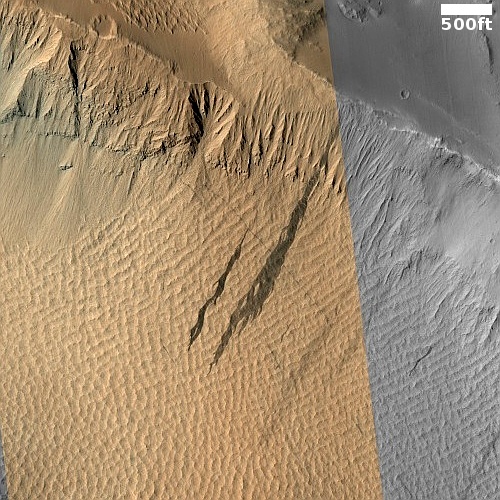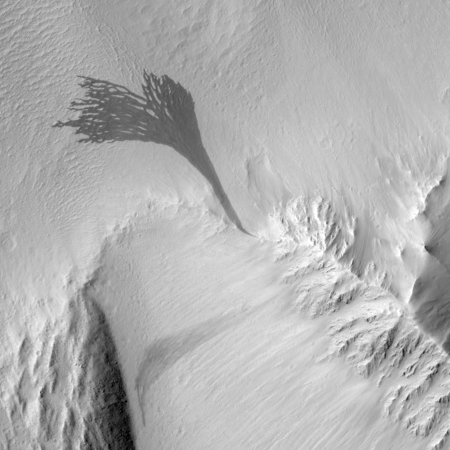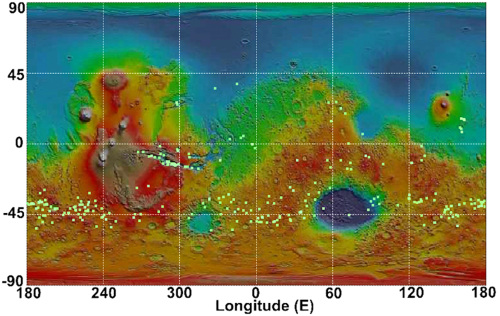New research suggests the two types of streaks on Mars are caused by dry events

A Martian slope streak caused by a dust devil? From
data taken in 2023. Click for original image.
Scientists using a computer machine learning algorithm to assembly and analyze global maps of all known slope streaks and recurring slope lineae (RSL) — the two different types of streaks found on Mars whose cause as yet remain unexplained — have concluded that these streaks are likely caused by dry processes, not wet brine seeping from underground.
Slope streaks can occur randomly throughout the year, can be bright or dark, can occur anywhere, and fade with time. Recurring slope lineae instead appear seasonally in the same locations and are always dark.
You can read the published paper here. It essentially provides further details on research that was first announced at a conference in March. From its conclusion:
[O]ur observations suggest that slope streak and RSL formation may be predominantly controlled by two independent, dry drivers, 1) the seasonal delivery of dust onto topographic inclines, and 2) the spontaneous activation of accumulated dust by energetic triggers – wind and impacts for slope streaks, as well as dust devils and rockfalls for RSL.
…Our results underline the fundamental differences between slope streaks and RSL, despite their visual resemblance. Streak and RSL populations occur on opposite hemispheres (north vs south), at different topographic elevations (mostly lowlands vs mostly highlands), in opposite thermal inertia terrain (low vs high), in different wind speed regimes (above-average vs below-average), in dissimilar diurnal thermal amplitude and heat flux terrain (above-average vs average), in different WEH, H2O, H, and water vapor column terrain (average vs below-average), and in terrain that provides suitable (theoretical) conditions for liquid water at different seasons (Ls ~90° vs Ls ~ 270°).
This data suggests both types of streaks form in connection with very fine Martian dust, but the researchers also admit that the actual method in which these avalanche-type streaks form remains unclear. In both cases the streaks cause no change in the topography (sometimes even traveling uphill for short distances), produce no debris piles at their base, as avalanches typically do, and do not appear to have an obvious cause or source at the top of the streak.

A Martian slope streak caused by a dust devil? From
data taken in 2023. Click for original image.
Scientists using a computer machine learning algorithm to assembly and analyze global maps of all known slope streaks and recurring slope lineae (RSL) — the two different types of streaks found on Mars whose cause as yet remain unexplained — have concluded that these streaks are likely caused by dry processes, not wet brine seeping from underground.
Slope streaks can occur randomly throughout the year, can be bright or dark, can occur anywhere, and fade with time. Recurring slope lineae instead appear seasonally in the same locations and are always dark.
You can read the published paper here. It essentially provides further details on research that was first announced at a conference in March. From its conclusion:
[O]ur observations suggest that slope streak and RSL formation may be predominantly controlled by two independent, dry drivers, 1) the seasonal delivery of dust onto topographic inclines, and 2) the spontaneous activation of accumulated dust by energetic triggers – wind and impacts for slope streaks, as well as dust devils and rockfalls for RSL.
…Our results underline the fundamental differences between slope streaks and RSL, despite their visual resemblance. Streak and RSL populations occur on opposite hemispheres (north vs south), at different topographic elevations (mostly lowlands vs mostly highlands), in opposite thermal inertia terrain (low vs high), in different wind speed regimes (above-average vs below-average), in dissimilar diurnal thermal amplitude and heat flux terrain (above-average vs average), in different WEH, H2O, H, and water vapor column terrain (average vs below-average), and in terrain that provides suitable (theoretical) conditions for liquid water at different seasons (Ls ~90° vs Ls ~ 270°).
This data suggests both types of streaks form in connection with very fine Martian dust, but the researchers also admit that the actual method in which these avalanche-type streaks form remains unclear. In both cases the streaks cause no change in the topography (sometimes even traveling uphill for short distances), produce no debris piles at their base, as avalanches typically do, and do not appear to have an obvious cause or source at the top of the streak.


